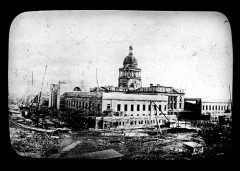
The first two Capitols in Lincoln were poorly constructed of inferior materials and by 1915 there was interest in building a third State Capitol. In January of 1919, the Legislature passed the Mears-Tracewell Bill to provide for construction of a new Capitol. Also included in the legislation were provisions for a Capitol Commission to oversee construction of the building, and provisions for a funding source.
The members of the Capitol Commission as prescribed by law were the Governor, ex-officio member and the chairman, and the four citizens he appointed with the approval of the Senate. They were to conduct the design competition and oversee construction. To help with the project they were given the power to hire a consulting architect and a construction engineer.
Thomas Rogers Kimball, FAIA, was selected as the Commission’s professional advisor, and he developed the design competition. Under his leadership the competition was opened to Nebraska firms and then a selected list of national architects. Bertram Grosvenor Goodhue was chosen by a three member jury of non-competing architects in June 1920.